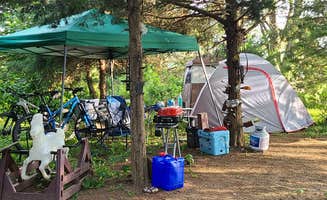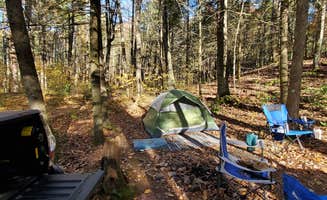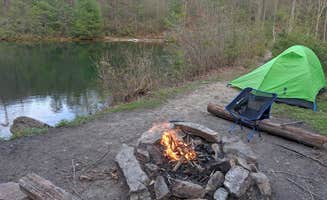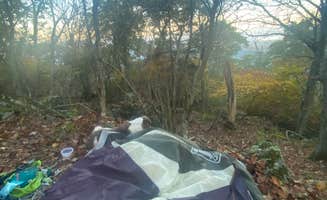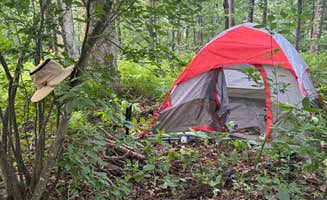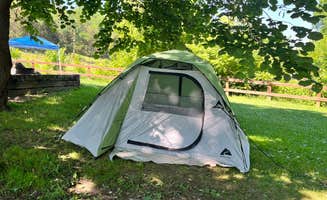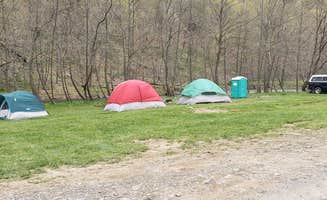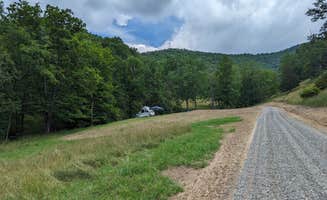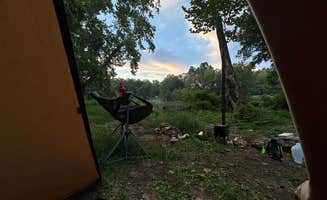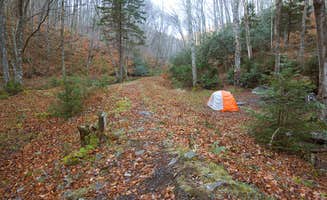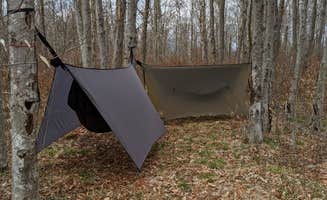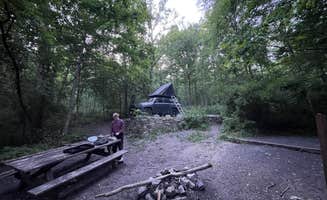The Shenandoah Valley region surrounding Dayton, Virginia offers primitive tent camping options within George Washington National Forest and nearby private land. Located at elevations between 1,200-3,000 feet, the area experiences temperature variations that can drop below 30°F during fall nights. Many campsites sit alongside creeks or small lakes, creating opportunities for fishing and wildlife viewing.
What to do
Creek exploration: At Hawk Nest Mushroom Farm, campers can explore the unique setting while learning about mushroom cultivation. As one camper shared, "We got a nice tour of the mushrooms currently growing at the farm. The camp area sits under a canopy of cedar trees."
Fishing opportunities: The streams and ponds provide fishing spots throughout the area. At Eagle Rock Campground, campers have direct access to the South Branch of the Potomac River. "The river is stocked with trout and there are some areas with catch and release instructions," notes one visitor.
Star viewing: With minimal light pollution at many sites, stargazing becomes an exceptional activity. One camper at Emerald Pond noted, "You get an amazing view of the night sky, unobstructed!"
Hiking trails: Multiple hiking options exist near tent sites. A Little Fort Campground visitor mentioned, "Nice trails/creek behind site," providing easy access to nature exploration.
What campers like
Privacy and seclusion: Many tent sites offer separation from other campers. At Switzer Lake Dispersed Camping, a camper noted, "I've camped here probably 12 times over the past 2 years and I seem to always find another awesome spot every time I go. There is a huge variety of spots, starting from huge ones right on the lake to more secluded, smaller spots deeper in the woods along the creek."
Waterfront access: Several camping areas provide direct water access. At Rock Tavern River Kamp, a visitor appreciated that "Our tent was about 20 feet from the river and the campground had everything we could have asked for."
Affordable options: Budget-conscious campers find free and low-cost sites throughout the region. One camper at Eagle Rock Campground stated simply, "$10 will get ya a nights stay. Like previously said drop your money in a slot and enjoy the river."
Simple check-in process: Many dispersed sites have straightforward procedures. A visitor to Little Fort Campground explained, "You select a campsite by flipping a washer on a hook on the board from green to red. Flip it back when you leave."
What you should know
Vehicle requirements: Several tent camping locations require specific vehicles. At Switzer Lake, a camper warned, "Once you turn onto Switzer Lake Rd from U.S. 33 and find the parking area to the lake on your left, be prepared to drive another 2ish miles on a single lane and very bumpy dirt road. Go slow as several sharp corners with huge drops and inexperienced drives coming towards you."
Cell service limitations: Most primitive camping areas lack reliable connectivity. At Little Fort, one visitor clarified, "On this app it says T-Mobile access, I'm a T-Mobile customer, no reception at all but drive 5 minutes back down the mountain and you're good to go."
Temperature fluctuations: Despite warm days, nights can get cold in this region. A camper at Emerald Pond advised, "I didn't expect temps to get as low as they did the night I went out there, but keep in mind it is fresh (cold) spring water and you're in the middle of two ridge lines, so it will get colder than the surrounding areas."
Wildlife awareness: Bear activity occurs throughout the camping areas. As one Switzer Lake visitor reported, "There are bears here, so lock up your food in the car. We have encountered a bear at or around the campsite 3 times."
Tips for camping with families
Mushroom farm experience: Families enjoy educational opportunities at Hazeltop Summit Dispersed Camping. A visitor shared, "They have a variety of lists based on hiking ability and difficulty as well as camping ability and difficulty so I recommend checking that out."
Noise considerations: Some sites experience more recreational activity than others. A Little Fort camper mentioned, "It is next to an off-road vehicle trail and there was a lot of action coming down until about 7 PM. Wouldn't have bothered me, but it did bother my dogs."
Swimming opportunities: Natural water features provide cooling options during summer months. At Emerald Pond, a camper explained, "We hike this bird knob trail all the time and usually end it by swimming across emerald pond. It's the perfect temperature (in July and august when we've done it)."
Food storage solutions: With wildlife present, proper food storage becomes essential. A camper at Laurel Prong Trail advised, "100% do not have food scents near your tent," after bears investigated their campsite during the night.
Tips from RVers
Site limitations: Many tent camping areas near Dayton have restrictions for larger vehicles. At Hawk Nest Mushroom Farm, a visitor cautioned, "If you are tent camping or have a camper van the area is fine. Large RV will have a difficult time setting up in the camp area."
Alternative accommodations: For those seeking more amenities, some locations offer both tent and RV options. A visitor to Crisman Hollow Road Camp shared, "It's a quiet area with many spots right on the water," making it suitable for various camping styles.
Seasonal closures: Not all roads remain open year-round. A Crisman Hollow visitor noted, "Some roads were closed," highlighting the importance of checking access before arrival, especially for vehicles with limited clearance.


